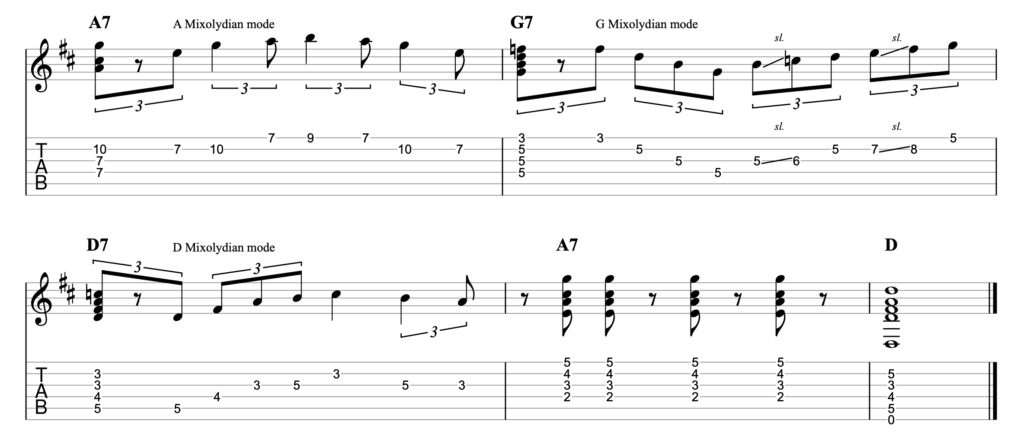The Mixolydian Mode
In the past, when someone started talking to me about modes my eyes would instantly glaze over. It all seemed too complicated for my liking, and the pentatonic scale served me just fine.
Eventually I realized that modes are actually wonderful tools that help expand one’s playing and knowledge of music.
And by the time you’re finished reading this article, you’ll be able to use it in your playing. Later in this article I provide an example of using the Mixolydian mode in a blues context.
What is it?
As mentioned in other articles, the major scale is the fundamental scale of Western music. If you learn the major scale well, you will always have a solid foundation for learning all other concepts of music theory. The video course Mastering Open D Tuning focuses a lot on this topic.
The Mixolydian mode can be thought of as simply a major scale with a flatted seventh degree. In other words, the D major scale and the D Mixolydian mode differ by only one note.

This means that if you know how to play the D major scale, you don’t have to learn an entirely new scale to play the D Mixolydian mode. All you have to do is change one note of the D major scale.
D Major: D-E-F#-G-A-B-C#-D
D Mixolydian: D-E-F#-G-A-B-C-D
When Can I Use The Mixolydian Mode?
The most straightforward application of the Mixolydian mode is to play it over a dominant seventh chord of the same name.
For example, over a D7 chord, you can play the D Mixolydian mode and it fits perfectly. Why? Because it contains all of the notes found in a the D7 chord.

The rule is simple: when you see a dominant seventh chord, you can play the matching Mixolydian scale.
Putting It Into Practice
Let’s say we’re playing a blues song that has the chords D7-G7-A7. Over each chord we can play the corresponding Mixolydian mode.

hear the example above:
In Conclusion
Adding the Mixolydian mode to our repertoire gives us an additional scale sound to work with that we can apply to nearly every song. To learn modes properly and gain the knowledge to endlessly expand your playing palette, it’s essential to learn the major scale properly. Once you have that as a foundation, there’s nothing stopping you.
If you’re interested in taking your playing to the next level and understanding music theory concepts, check out the 3+ hour video course Mastering Open D Tuning.
In the next article on the Mixolydian mode I’ll discuss a cool hack that you can use to find the Mixolydian mode on the fretboard super quickly.
Until then, happy playing!
Join our mailing list to receive the latest tips!
RELATED LESSONS YOU’LL ENJOY: